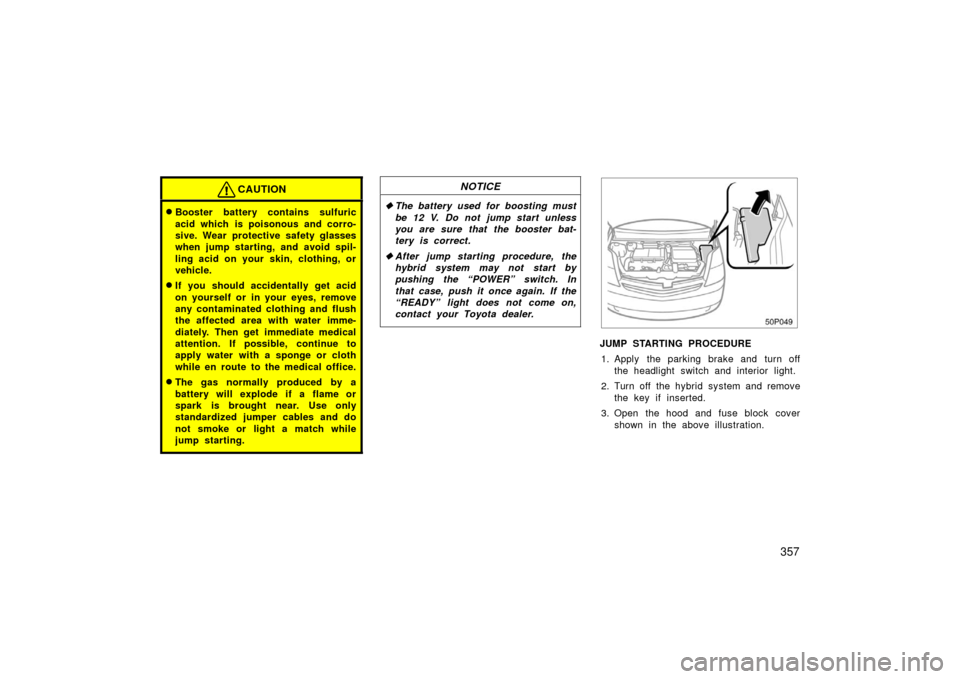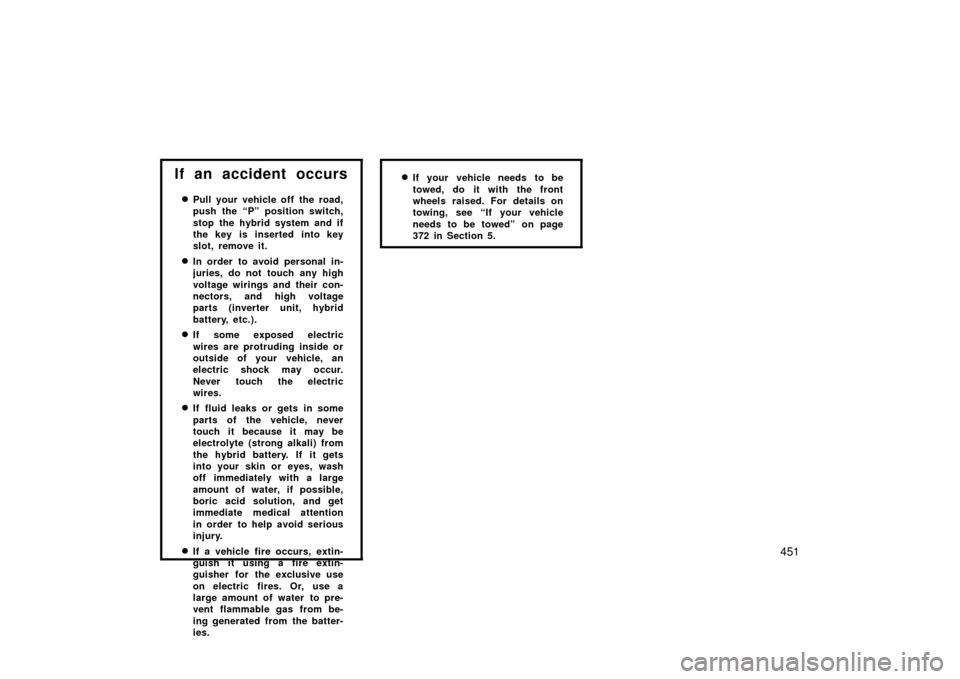Page 356 of 455

356
Before making these checks, make sure
you have followed the correct starting
procedure given in “How to start the
hybrid system” on page 348 and that you
have sufficient fuel. Also check whether
the other keys will start the hybrid
system. If they work, your key may be
broken. Have the key checked at your
Toyota dealer. If none of your keys work,
there may be a malfunction in the hybrid
vehicle immobilizer system. Call your
Toyota dealer. (See “Keys” on page 20.)
If the instrument cluster dims or the
instrument cluster display turns off
with the hybrid system on—1. Check that the 12 volt battery terminals are tight and clean.
2. If the 12 volt battery terminals are O.K., the 12 volt battery is discharged.
You may try jump starting. See “(b)
Jump starting” for further instructions.
NOTICE
Hybrid vehicles cannot be push�
started.
If the instrument cluster is shown in
appropriate brightness when the hybrid
system is in the “IG�ON” mode—
The hybrid vehicle system is suspected to
be faulty. Contact your Toyota dealer. If the 12 volt battery is discharged, the
hybrid system can be started by jump
starting. Depending on the vehicle con-
dition, the engine may not start.
To avoid serious personal injury and
damage to your vehicle which might re-
sult from battery explosion, acid burns,
electrical burns, or damaged electronic
components, these instructions must be
followed precisely.
If the 12 volt battery is discharged, you
cannot access to the 12 volt battery in the
luggage compartment because the back
door cannot be opened. Use the exclusive
jump starting terminal in the engine
compartment. For details, see “JUMP
STARTING PROCEDURE” on page 357.
NOTICE
If the 12 volt battery is discharged
with the transaxle in “P”, your vehicle
cannot be moved unless the front
wheels are raised. This is because the
front wheels are locked by means of
the parking lock mechanism.
If you are unsure about how to follow this
procedure, we strongly recommend that
you seek the help of a competent qualified
technician or towing service.
If your vehicle will not start—
(a) Simple checks
(b) Jump starting
Page 357 of 455

357
CAUTION
�Booster battery contains sulfuric
acid which is poisonous and corro-
sive. Wear protective safety glasses
when jump starting, and avoid spil-
ling acid on your skin, clothing, or
vehicle.
�If you should accidentally get acid
on yourself or in your eyes, remove
any contaminated clothing and flush
the affected area with water imme-
diately. Then get immediate medical
attention. If possible, continue to
apply water with a sponge or cloth
while en route to the medical office.
�The gas normally produced by a
battery will explode if a flame or
spark is brought near. Use only
standardized jumper cables and do
not smoke or light a match while
jump starting.
NOTICE
�The battery used for boosting must
be 12 V. Do not jump start unless
you are sure that the booster bat-
tery is correct.
� After jump starting procedure, the
hybrid system may not start by
pushing the “POWER” switch. In
that case, push it once again. If the
“READY” light does not come on,
contact your Toyota dealer.
50p049
JUMP STARTING PROCEDURE
1. Apply the parking brake and turn off the headlight switch and interior light.
2. Turn off the hybrid system and remove the key if inserted.
3. Open the hood and fuse block cover shown in the above illustration.
Page 429 of 455

429
12 VOLT BATTERY
Open voltage at 20�C (68 �F):
12.6 − 12.8 V Fully charged
12.2 − 12.4 V Half charged
11 . 5 − 11.9 V Discharged
[Voltage that is checked 20 minutes after
the key is removed with all the lights
turned off]
Charging rates: 3.5 A max.
HYBRID TRANSAXLE
Fluid capacity (drain and refill),
L (qt., Imp.qt.): 3.6 (3.8, 3.2)
Fluid type: “Toyota Genuine ATF WS” or
equivalent
Please contact your Toyota dealer for further
details. BRAKES
Minimum pedal clearance when depressed
with the force of 196 N (20 kgf, 44 lbf)
with the traction motor running, mm (in.):
101.0 (3.98)
Pedal free play, mm (in.): 1 − 4 (0.04 − 0.16)
Parking brake adjustment when depressed
with the force of 294 N (30 kgf, 66 lbf): 6 − 9 clicks
Fluid type: SAE J1703 or FMVSS No. 116 DOT 3
STEERING
Wheel free play: Less than 30 mm (1.2 in.)
Tires
Tire size and inflation pressure:
Tire size kPa (kgf/cm
2 or ba r, ps i )
Standard Front
P185/65R15 86S 240 (2. 4, 35)
Rear
P185/65R15 86S 230 (2. 3, 33)
Spare T125/70D16 96M 420 (4. 2, 60)
Wheel size: Standard 15 x 6JJ
S par e 16 x 4T
Wheel nut torque, N·m (kgf·m,
ft·lbf): 103 (10.5, 76)
NOTE: For a complete information on tires (e.g. replacing tires
or replacing wheels), see
“Checking tire inflation pres-
sure” through “Aluminum
wheel precautions”, page
405 through 412.
Page 451 of 455

451
If an accident occurs
�Pull your vehicle off the road,
push the “P” position switch,
stop the hybrid system and if
the key is inserted into key
slot, remove it.
�In order to avoid personal in-
juries, do not touch any high
voltage wirings and their con-
nectors, and high voltage
parts (inverter unit, hybrid
battery, etc.).
�If some exposed electric
wires are protruding inside or
outside of your vehicle, an
electric shock may occur.
Never touch the electric
wires.
�If fluid leaks or gets in some
parts of the vehicle, never
touch it because it may be
electrolyte (strong alkali) from
the hybrid battery. If it gets
into your skin or eyes, wash
off immediately with a large
amount of water, if possible,
boric acid solution, and get
immediate medical attention
in order to help avoid serious
injury.
�If a vehicle fire occurs, extin-
guish it using a fire extin-
guisher for the exclusive use
on electric fires. Or, use a
large amount of water to pre-
vent flammable gas from be-
ing generated from the batter-
ies.
�If your vehicle needs to be
towed, do it with the front
wheels raised. For details on
towing, see “If your vehicle
needs to be towed” on page
372 in Section 5.
Page:
< prev 1-8 9-16 17-24